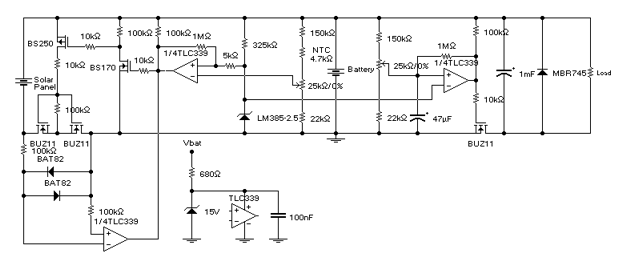Solar charger for lead-acid batteries
This circuit is still under development, but works well as shown.
This circuit is intended for charging lead-acid batteries with a solar panel. The customary diode that prevents the battery from discharging through the solar panel has been replaced by a FET-comparator combination. The charger will stop charging once a pre-set voltage (temperature compensated) has been reached, and recommence charging when the voltage has dropped off sufficiently. The load is disconnected when the baterry voltage drops below 11V and reconnected when it gets back to 12.5V.
The circuit has the following features:
-
Charges until Vbat = 13,8V (adjustable), then float charges;
-
Shuts down load when Vbat < 11V (adjustable), resets at 12,5V;
-
Temperature compensation;
-
Will work with cheap and readily available components like LM393 comparators and BUZ11 FETs;
-
Uses less than 1.3mA (Attempts to use micropower comparators have failed spectacularly so far, see below);
-
Burns less than 20mW in FETs when charging at 0,5A. (More expensive FETs with a lower RDSON will yield even better results).
Note that the charging current is limited only by the solar panel used.
Here's the circuit:

Note the funny place of grounding of the first 2 comparators. There's some weirdness here: this bit of the circuit gives me headaches. Two problems:
-
If I ground the first two comparators (LM393) in the same place as the third, i.e. not between the FETs, the thing won't work and the battery will discharge over the solar panel. Why? Am I playing to close to the rails? How can this be remedied/improved/redesigned? Do I need a diode between the comparator's imputs?
-
If I use micropower comparators like the Texas Instruments TLC393, the comparators blow up spectacularly, but with the standard LM393 everything works fine. Why? What did I miss?
Help would be greatly appreciated!
Next attempt
This one works fine and uses about 0.5mA, but that might improve because I'm not done tweeking yet:
by Oscar den Uijl, odu@xs4all.nl







